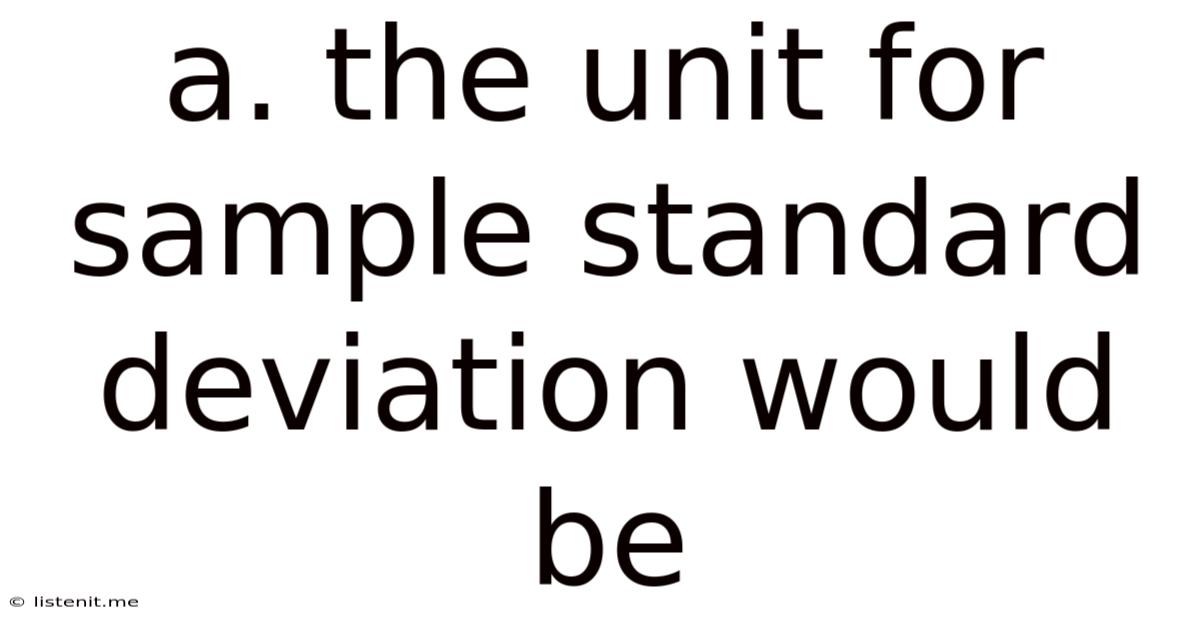A. The Unit For Sample Standard Deviation Would Be
listenit
Jun 11, 2025 · 4 min read

Table of Contents
The Unit for Sample Standard Deviation: A Deep Dive
The sample standard deviation, a cornerstone of descriptive statistics, measures the dispersion or spread of a dataset around its mean. Understanding its unit is crucial for interpreting results and communicating findings accurately. This article delves deep into the unit of sample standard deviation, exploring its relationship with the data's unit, providing practical examples, and addressing common misconceptions.
Understanding Sample Standard Deviation
Before we delve into the unit, let's quickly recap what sample standard deviation represents. It quantifies how much individual data points deviate from the average (mean) of the sample. A high standard deviation indicates that the data points are widely scattered, while a low standard deviation signifies that they are clustered closely around the mean.
The formula for sample standard deviation (often denoted as 's') is:
s = √[ Σ(xi - x̄)² / (n - 1) ]
Where:
- xi represents each individual data point.
- x̄ represents the sample mean (average).
- n represents the sample size.
- Σ denotes the summation of all values.
- (n - 1) is used instead of 'n' in the denominator to provide an unbiased estimator of the population standard deviation.
The Unit of Sample Standard Deviation: Same as the Data
The crucial takeaway here is this: the unit of the sample standard deviation is the same as the unit of the original data.
This seemingly simple fact is often overlooked. If your data is measured in kilograms, then your sample standard deviation will also be in kilograms. If your data represents temperatures in Celsius, the standard deviation will also be in Celsius. This consistency is fundamental to interpreting the results meaningfully.
Examples Illustrating the Unit
Let's solidify this concept with some concrete examples:
Example 1: Heights of Students
Suppose you measure the heights of 20 students in a class, and the heights are recorded in centimeters (cm). After calculating the sample standard deviation, you obtain a value of, say, 5 cm. This means the average deviation of individual student heights from the mean height is 5 centimeters. The unit remains consistent.
Example 2: Weights of Apples
Imagine you weigh 30 apples, recording their weights in grams (g). The calculated sample standard deviation is 10 g. This tells us that, on average, the weights of individual apples deviate from the mean weight by 10 grams. The unit remains the same – grams.
Example 3: Exam Scores
Let's say you've collected exam scores from a group of students. The scores are dimensionless (pure numbers, no units). In this case, the sample standard deviation will also be a dimensionless number, reflecting the average deviation of the scores from the mean score.
Why the Unit Matters: Interpretation and Communication
The unit of the sample standard deviation is not just a technicality; it's essential for correct interpretation and effective communication of results.
-
Meaningful Interpretation: Without the unit, the value of the standard deviation is meaningless. A standard deviation of 5 is vastly different depending on whether it's 5 centimeters, 5 kilograms, or 5 degrees Celsius. The unit provides context and allows us to understand the magnitude of the variability.
-
Clear Communication: When presenting your findings, including the unit with the standard deviation is critical. This avoids ambiguity and ensures your audience correctly understands the scale of the data's variability. Imagine a report stating, "The standard deviation of the product's lifespan is 10." Without specifying the unit (e.g., 10 months, 10 years, 10 days), the information is incomplete and potentially misleading.
Common Misconceptions
Several common misunderstandings surround the unit of sample standard deviation:
-
Squaring and Square Rooting: The formula involves squaring the deviations (in the numerator) and then taking the square root. Some mistakenly think this alters the unit. However, squaring a unit simply means multiplying it by itself (e.g., cm x cm = cm²). Taking the square root reverses this, returning the unit to its original form.
-
Dimensionless Data: Even with dimensionless data (like exam scores or percentages), the standard deviation retains its unitless nature. It still represents the average deviation from the mean, but there's no physical unit associated with it.
Advanced Considerations: Population Standard Deviation
While we've focused on sample standard deviation, it's important to briefly mention population standard deviation (often denoted as 'σ'). The formula is similar, but it uses 'n' instead of '(n-1)' in the denominator. The unit for population standard deviation is also the same as the unit of the original data – this fundamental principle remains consistent.
Conclusion: The Unit is Key
The unit of sample standard deviation is identical to the unit of the original data. This seemingly simple point is crucial for accurate interpretation and clear communication of statistical findings. Always report the standard deviation with its corresponding unit to ensure that your results are understood correctly and avoid potential misinterpretations. Understanding the unit's significance enhances your analytical skills and improves your ability to effectively communicate your statistical results within various contexts. Remember, attention to detail and clear communication are essential for effective data analysis and interpretation. Ignoring the unit can lead to flawed conclusions and misinformed decisions.
Latest Posts
Latest Posts
-
Describe The Importance Of The Inner Membranes Separating Different Regions
Jun 12, 2025
-
Why Is Mercury Used In Thermometers
Jun 12, 2025
-
Epstein Barr Virus And Breast Cancer
Jun 12, 2025
-
How Long Can Ticks Live Under Water
Jun 12, 2025
-
Journaling And Thought Records In Cbt
Jun 12, 2025
Related Post
Thank you for visiting our website which covers about A. The Unit For Sample Standard Deviation Would Be . We hope the information provided has been useful to you. Feel free to contact us if you have any questions or need further assistance. See you next time and don't miss to bookmark.